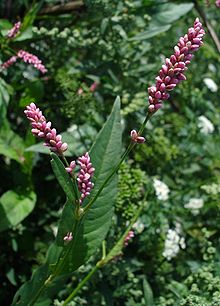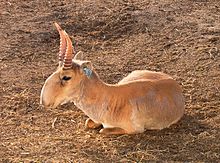Mammoth steppe
| Mammoth steppe | |
| Area share | in the Holocene : 0% in the Pleistocene varying 0–10% of the land surface |
| Land use | primarily large animal hunting in the Paleolithic |
| biodiversity | medium |
| Biomass | low to high |
| Exposure to sunlight | high |
| Ø temperatures | Annual mean below 0 ° C |
| Annual precipitation | low |
| Water balance | Permafrost soil |
| Growing season | about 90 days |

Light pink: mammoth steppe in northern Eurasia
The mammoth steppe or steppe-tundra is a special form of the steppe , which during the cold periods of the Pleistocene - especially Saalian and Weichselian - for much of the unglaciated northern Eurasia from Central Europe to East Asia as well as time, in North America had spread. A comparable type of vegetation no longer exists today.


white: glaciation ; pink dashed line: southern limit of the tundra; white dotted line: southern limit of the permafrost ground ; green line: steppe / tree line; yellow hatching: loess desert .
Mammoth steppe in permafrost: between a pink dashed line in the north and a white dotted line in the south.
causes
The creation of mighty inland ice sheets and the resulting retreat of the seas resulted in a dry continental climate. The grinding activity of the glaciers and subsequent deflation also resulted in fine loess and sand dust , which was deposited as a layer of clay in extensive areas, especially along the seasonally dry river courses .
Since the annual average temperature of −1 ° C and the annual precipitation did not exceed 1000 millimeters, a permafrost soil formed under the mammoth steppe , which did not allow vegetation by trees. The thickness of the ice sheet was u. a. determined by the accumulated precipitation.
Often the mammoth steppe is compared to today's tundra because of these conditions , but this is only partially justified. Separating features are above all the different positions of the sun and the associated season cycles, which set the mammoth steppe with its largely predominant light conditions in the middle latitudes apart from the northern tundra with pronounced polar summers and winters. This resulted in a species-rich and, above all, nutrient-rich vegetation, which was also favored by the long-lasting high pressure situations that occur due to the nearby glaciers.
Reconstruction problems
The determination of the past plant community is problematic, as the only sparsely woody plants have hardly been preserved in fossil form . Samples for analyzes come mainly from the still frozen permafrost soil of the subpolar zone , in which a tundra climate has prevailed up to the present day . But this distorts the specific differences in vegetation between the mammoth steppe and today's tundra . Furthermore, the mammoth steppe extended over a very large area of the earth's surface, which cannot be expected to be uniform. Accordingly, results on the vegetation of the mammoth steppe are controversial.
In today's landscape there is no direct comparison to the mammoth steppe biotope . The treeless high mountain areas come closest to it, such as the Alm or Central Asian high mountain valleys.


flora
The dry and cold conditions provided the ideal space for the development of the mammoth steppe, where steppe and tundra plants mix. The landscape was almost free of trees, the predominant plant species included grasses , sedge , herbs , dwarf birch and polar willow . The image of the mammoth steppe is predominantly shaped by a grass steppe.
By analyzing the contents of the digestive tracts of woolly mammoths from the permafrost of various sites in Northern Siberia, individual groups of plants or species could be identified. Mainly the wind pollinators were sweet grasses (Poaceae), sour grass plants (Cyperaceae) and Artemisia , also herb willow ( Salix herbacea ); Also insect pollinated herbs such Grasnelken ( Armeria ), Jacob's ladder ( Polemonium ), flea smartweed ( Persicaria maculosa ), Caryophyllaceae (Caryophyllaceae), Compositae (Asteraceae tubuliflorae and A. liguliflorae) and epipactis ( Epipactis ).
Investigations of the soil by means of DNA analyzes reveal a more herb-rich vegetation. According to DNA studies from areas that have been exposed to permafrost to this day, herbs consumed up to 63% of the plant community during the final freezing phase. Plantain , mugwort and chrysanthemums were typical . In contrast, sweet grasses only achieved about 27%.


fauna
In addition to the character animal of this habitat, the woolly mammoth ( Mammuthus primigenius ), the inhabitants of this steppe also included other large mammals such as the woolly rhinoceros ( Coelodonta antiquitatis ), the musk ox ( Ovibos moschatus ), the reindeer ( Rangifer tarandus ), the saiga antelope ( Saiga tatarica ), but also the extinct steppe bison ( Bison priscus ) and the Ice Age wild horse subspecies Equus caballus lenensis . The large animals not only fed on grasses, as was originally assumed, but also on herbaceous plants, which was proven by the stomach contents of cadavers from the permafrost, for example on the ice mummy discovered in 2007 near the Kolyma River in Siberia Woolly rhinoceros, which contained over 52% remains of herbaceous plants. It is not clear whether the grazing activities of these megaherbivores created this specific landscape form and it disappeared after the animals became extinct, or whether the disappearance of this landscape form led to the typical large mammals becoming extinct.
History of terminology
At the end of the 19th century, Alfred Nehring (1890) and Iwan Dementjewitsch Tscherski (1891) had the idea that a large part of Northern Europe was populated by large grass-eaters during the last glacial period and that a steppe-like climate prevailed there. In 1982 R. Dale Guthrie proposed the term "mammoth steppe" for this paleoregion.
Experimental reconstruction
A project that could help clarify this question is being carried out in north-eastern Siberia in the form of a Pleistocene park . Here one tries to transform the tundra back into a mammoth steppe by grazing with large herbivores.
Individual evidence
- ↑ a b c d Wighart von Koenigswald: Lebendige Eiszeit. Climate and fauna in transition. Stuttgart 2002, pp. 140-152.
- ↑ Peter U. Clark, Arthur S. Dyke, Jeremy D. Shakun, Anders E. Carlson, Jorie Clark, Barbara Wohlfarth, Jerry X. Mitrovica, Steven W. Hostetler, A. Marshall McCabe: The Last Glacial Maximum . In: Science . tape 325 , no. 5941 , 2009, p. 710-714 .
- ↑ a b Ralf-Dietrich Kahlke and Dick Mol: Ice Age Large Mammals of the Siberian Arctic. The Cerpolex / Mammuthus expeditions on Tajmyr. E. Schweizerbart'sche Verlagbuchhandlung (Nägele and Obermiller), Stuttgart 2005.
- ^ Lexicon of Geosciences . tape 2. , 2000, pp. 326 .
- ^ Hansjürgen Müller-Beck : The Ice Ages. Natural history and human history. Munich 2005, ISBN 3-406-50863-4 .
- ↑ Russel Dale Guthrie: The Frozen Fauna of the Mammoth Steppe: The Story of Blue Babe. University of Chicago Press, 1990 Preview in Google Book Search .
-
↑ Bas van Geel, André Aptroot, Claudia Baittinger, Hilary H. Birks, Ian D. Bull, Hugh B. Cross, Richard P. Evershed, Barbara Gravendeel, Erwin JO Kompanje, Peter Kuperus, Dick Mol, Klaas GJ Nierop, Jan Peter Pals, Alexei N. Tikhonov, Guido van Reenen, Peter H. van Tienderen: The ecological implications of a Yakutian mammoth's last meal. (PDF) In: Quaternary Research , Volume 69, 2008, pp. 361-376.
• D. Mol, Y. Coppens, AN Tikhonov, LD Agenbroad, RDE MacPhee, C. Flemming, A. Greenwood, B. Buigues, C. de Marliave, B. van Geel, GBA van Reenen, JP Pals, DC Fisher, D. Fox: The Jarkov Mammoth: 20,000-year-old carcass of a Siberian woolly mammoth Mammuthus primigenius (Blumenbach, 1799). ( Memento from February 3, 2015 in the Internet Archive ) (PDF) In: Proceedings of the 1st International Congress 'The World of Elephants' Roma, 2001.
• AA Andreev, PE Tarasov, C. Siegert, T. Ebel, VA Klimanov, M. Melles, AA Bobrov, A. Yu. Dereviagin, DJ Lubinski, H.-W. Hubberten: Late Pleistocene and Holocene vegetation and climate on the northern Taymyr Peninsula, Arctic Russia. In: Boreas , Vol. 32, pp. 484-505.
• D. Mol, A. Tikhonov, J. van der Plicht, RD Kahlke, R. Debruyne, B. VanGeel, G. van Reenen, JP Pals, C. de Marliave, JWF Reumer: Results of the CERPOLEX / Mammuthus Expeditions on the Taimyr Peninsula, Arctic Siberia, Russian Federation. In: Quaternary International , Vol. 142-143, 2006, pp. 186-202.
• AV Sher, SA Kuzmina, TV Kuznetsova, LD Sulerzhitsky: New insights into the Weichselian environment and climate of the East Siberian Arctic, derived from fossil insects, plants, and mammals. In: Quaternary Science Reviews , Volume 24, 2005, pp. 533-569. - ↑ Nadja Podbregar: The myth of the mammoth steppe . On: Wissenschaft.de on February 5, 2014, accessed on September 9, 2019.
- ↑ a b c Eske Willerslev, John Davison, Mari Moora, Martin Zobel, Eric Coissac, Mary E. Edwards, Eline D. Lorenzen, Mette Vestergård, Galina Gussarova, James Haile, Joseph Craine, Ludovic Gielly, Sanne Boessenkool, Laura S. Epp, Peter B. Pearman, Rachid Cheddadi, David Murray, Kari Anne Bråthen, Nigel Yoccoz, Heather Binney, Corinne Cruaud, Patrick Wincker, Tomasz Goslar, Inger Greve Alsos, Eva Bellemain6, Anne Krag Brysting, Reidar Elven, Jørn Henrik Sønstebø, Julian Murton, Andrei Sher, Morten Rasmussen, Regin Rønn, Tobias Mourier, Alan Cooper, Jeremy Austin, Per Möller, Duane Froese, Grant Zazula, Francois Pompanon, Delphine Rioux, Vincent Niderkorn, Alexei Tikhonov, Grigoriy Savvinov, Richard G. Roberts, Ross DE MacPhee, M. Thomas P. Gilbert, Kurt H. Kjær, Ludovic Orlando, Christian Brochmann and Pierre Taberle: Fifty thousand years of Arctic vegetation and megafaunal diet. In: Nature , Volume 506, 2014, pp. 47-51 doi: 10.1038 / nature12921 .
- ↑ Gennady G. Boeskorov, Peter A. Lazarev, Andrei V. Sher, Sergei P. Davydov, Nadezhda T. Bakulina, Marina V. Shchelchkova, Jonas Binladen, Eske Willerslev, Bernard Buigues and Alexey N. Tikhonov: Woolly rhino discovery in the lower Kolyma River. In: Quaternary Science Reviews. Volume 30, 2011, pp. 2262-2272.
- ↑ Axel Beutler: The large animal fauna of Europe and their influence on vegetation and landscape. In: B. Gerken and C. Meyer (eds.): Where did plants and animals live in the natural and early cultural landscapes of Europe? Natur- und Kulturlandschaft 1, 1996, pp. 51-106.
- ↑ Margret Bunzel-Drüke, Joachim Drüke and Henning Vierhaus: The influence of large herbivores on the natural landscape of Central Europe. Working Group on Biological Environmental Protection District Soest e. V. 2001.
- ↑ A. Nehring : About tundras and steppes of the present and past: with special consideration of their fauna . F. Dümmler, Berlin 1890 ( limited preview in the Google book search).
- ↑ ID Chersky: Description of the post-Tertiary mammal collection found byNew Siberian expedition from 1885 to 1886. In: Notes of Russian Academy of Science , Volume 65, 1891, p. 706.
- ↑ a b Mikhail S. Blinnikov, Benjamin Gaglioti, Donald A. Walker, Matthew J. Wooller, Grant D. Zazula: Pleistocene graminoid-dominated ecosystems in the Arctic. In: Quaternary Science Reviews , Volume 30, October 2011, pp. 2906-2929, doi : 10.1016 / j.quascirev.2011.07.002 .
- ^ R. Dale Guthrie: Mammals of the mammoth steppe as paleoenvironmental indicators. In: DM Hopkins, CE Schweger, SB Young (Eds.): Paleoecology of Beringia . Academic Press, New York 1982, pp. 307-329.
